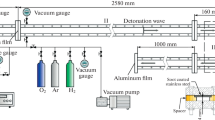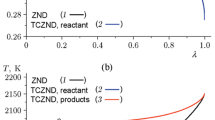Abstract
Detonations in non-ideal explosives tend to propagate significantly below the nominal one-dimensional detonation speed. In these cases, multi-dimensional effects within the reaction zone are important. A streamline-based approach to steady-state non-ideal detonation theory is developed. It is shown in this study that, given the streamline shapes, the two-dimensional problem reduces to an ordinary differential equation eigenvalue problem along each streamline, the solution of which determines the local shock shape that, in turn, leads to the solution of the detonation speed as a function of charge diameter. A simple approximation of straight but diverging streamlines is considered. The results of the approximate theory are compared with those of high-resolution direct numerical simulations of the problem. It is shown that the straight streamline approximation is remarkably predictive of highly non-ideal explosive diameter effects. It is even predictive of failure diameters. Given this predictive capability, one potential use of the method is in the determination of rate law parameters by fitting to data from unconfined rate stick experiments. This is illustrated by using data for ammonium nitrate fuel oil explosives.
Similar content being viewed by others
References
Lee EL, Tarver CM (1980) Phenomenological of shock initiation in heterogeneous explosives. Phys Fluids 23(12): 2362–2372
Kapila AK, Schwendeman D, Bdzil JB, Henshaw WD (2007) Study of detonation diffraction in the ignition-and-growth model. Combust Theory Model 11(5): 781–822
Bdzil JB, Aslam TD, Catanach RA, Hill LG, Short M (2002) DSD front models: nonideal explosive detonation in ANFO. In: Proceedings of the 12th detonation symposium, pp 409–417
Catanach RA, Hill LG (2001) Diameter effect curve and detonation front curvature measurements of ANFO. In: Proceedings of the 12th shock compression of condensed matter, 2001, pp 906–909
Short M, Salyer TR, Aslam TD, Kiyanda CB, Morris JS, Zimmerly T (2009) Detonation shock dynamics calibration for non-ideal HE: ANFO. In: Proceedings of APS shock compression condensed matter, pp 189–192
Bdzil JB, Stewart DS (2007) The dynamics of detonation in explosive systems. Ann Rev Fluid Mech 39: 263–292
Sharpe GJ, Luheshi MY, Braithwaite M, Falle SAEG (2009) Steady non-ideal detonation. In: Proceedings of the 16th APS shock compression condensed matter, pp 452–457
Aslam TD, Bdzil JB, Hill LG (1998) Analysis of rate stick data for PBX9502. In: Proceedings of the 11th detonation symposium, pp 906–909
Short M, Bdzil JB (2003) Propagation laws for steady curved detonations with chain-branching kinetics. J Fluid Mech 479: 39–64
Kasimov AR, Stewart DS (2005) Asymptotic theory of evolution and failure of self-sustained detonations. J Fluid Mech 525: 161–192
Sharpe GJ, Braithwaite M (2005) Steady non-ideal detonations in cylindrical sticks of explosives. J Eng Math 53: 39–58
Byers Brown W (2002) Thermodynamic theory of non-ideal detonation and failure. In: Proceedings of the 12th detonation symposium, pp 718–723
Watt SD, Sharpe GJ, Falle SAEG (2010) A streamline approach to steady non-ideal detonation theory. In: Proceedings of the 14th detonation symposium, pp 797–805
Aslam TD, Bdzil JB (2002) Numerical and theoretical investigations of detonation-inert confinement interactions. In: Proceedings of th 12th detonation symposium, pp 484–488
Cowperthwaite M (1994) An exact solution for axial-flow in cylindrically symmetrical, steady-state detonation in polytropic explosive with an arbitrary rate of decomposition. Phys Fluids 6: 1357–1378
Fickett W, Davis W (1979) Detonation. University of California Press, Berkeley
Sharpe GJ, Gorchkov V, Short M (2008) Shock initiation of explosives: the idealized condensed-phase model. IMA J Appl Math 73: 361–373
Short M, Anguelova I, Aslam TD, Bdzil JB, Henrick A, Sharpe GJ (2008) Stability of detonations for an idealized condensed-phase model. J Fluid Mech 595: 45–82
Vidal P, Bouton E, Presles H-N (1995) Some features of the curvature of a 2-dimensional detonation front at a simple refraction locus. J Phys IV 5:C4.49–C4.56
Van Dyke M (1975) Perturbation methods in fluid mechanics. Parabolic Press, California
Bdzil JB (1981) Steady-state two-dimensional detonation. J Fluid Mech 108: 195–226
Sharpe GJ, Bdzil JB (2006) Interactions of inert confiners with explosives. J Eng Math 54: 273–298
Aslam TD, Bdzil JB Private communications
Author information
Authors and Affiliations
Corresponding author
Rights and permissions
About this article
Cite this article
Watt, S.D., Sharpe, G.J., Falle, S.A.E.G. et al. A streamline approach to two-dimensional steady non-ideal detonation: the straight streamline approximation. J Eng Math 75, 1–14 (2012). https://doi.org/10.1007/s10665-011-9506-0
Received:
Accepted:
Published:
Issue Date:
DOI: https://doi.org/10.1007/s10665-011-9506-0




